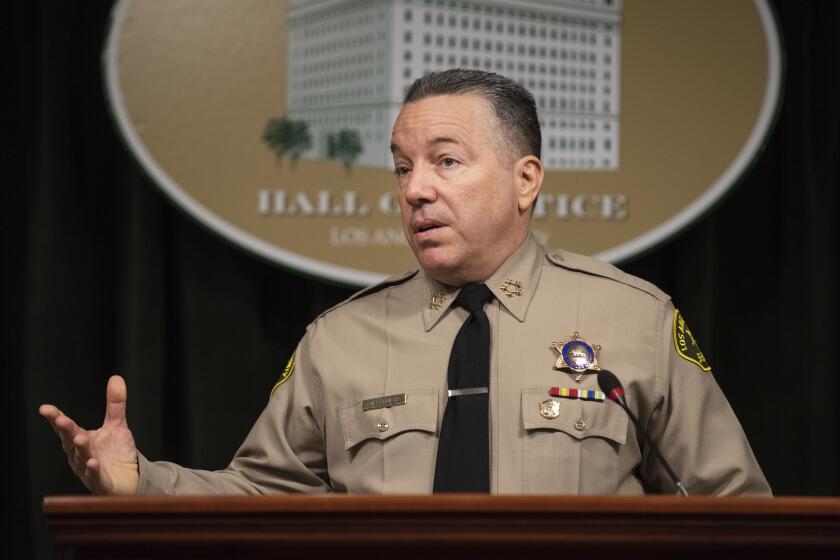Summer bummer in Long Beach
Donna Martin put on her bathing suit Monday morning and drove her 17-year-old daughter and a neighbor’s 4-year-old over to Mother’s Beach in Long Beach, psyched to take a dip.
A red and yellow warning sign killed the mood: “Beach Closed. Sewage Contaminated Water. Ocean Water May Cause Illness.”
Martin, 48, a Long Beach native, was disappointed -- but not surprised.
“It seems like it’s a common occurrence that they close this beach,” she said.
Long Beach is experiencing a beach buzz-kill this summer thanks to a series of sewage spills that have kept popular shoreline spots like Mother’s Beach off limits.
Long Beach has seen 31 sewage spills since January, four of them so severe that officials had to close the beaches. That’s about 10 fewer spills than this time last year, but three more beach closures.
Officials say there have been more beach closures this year because of where the sewage spilled.
“We just had a couple that were closer to the beach,” said Nelson Kerr, recreational water manager at the city’s Department of Health and Human Services.
On Saturday, a 12,000-gallon sewage spill near Spinnaker Bay closed Mother’s Beach, Marine Stadium, Colorado Lagoon and Alamitos Bay. The closures forced organizers to postpone the annual Naples Island Swim competition Sunday.
Beaches were not expected to reopen until this morning at the soonest.
Some of the water quality issues are homegrown. Cleaning crews responsible for maintaining the city’s 760 miles of sewer lines traced Saturday’s spill to an 8-inch pipe below a gated community that was clogged with cooking grease. A 300-gallon spill July 13 that closed several beaches was caused by vandals stuffing toilet paper down public toilets near Mother’s Beach, city officials said.
Other water problems flow downstream from Los Angeles. Unlike other beach cities, Long Beach is inundated with polluted water from the San Gabriel and Los Angeles rivers, say environmental experts at groups like Heal the Bay.
The beach closures -- three in less than two months -- are particularly bitter for Long Beach because the city has been trying to improve the water quality of its beaches by staging cleanups, commissioning environmental studies and sending cleaning crews to scour problem sewer pipes.
“Despite Long Beach’s best efforts to minimize poor local water quality, they will continue to be at the mercy of the entire L.A. and San Gabriel River watershed’s runoff,” said Mike Grimmer, who manages Heal the Bay’s beach report card program.
In June, a 16,000-gallon sewage spill in Glendale flowed down the L.A. River to Long Beach, leading officials to close a 2-mile stretch of beach near Belmont Pier. A 75,000-gallon sewage spill near Griffith Park drifted down the L.A. River on Jan. 29 to the Long Beach coast.
“Long Beach is the recipient of everyone else’s problems, whether it’s storm water or sewage flows,” said Ryan Alsop, a spokesman for the city’s water department. He called the rivers “big latrines.”
“Everything that’s in them is emptied out into our harbor areas,” he said.
While some of Long Beach’s dirty water comes from pollution upstream, the latest closure was due to a local problem: cooking grease that has clogged city sewer lines from an upscale housing development along the shoreline.
Alsop said residents could help prevent future beach closures, and save on sewer fees, by throwing grease in the trash, as required by state and city law, instead of down the drain.
Added sewer line cleanings cost residents an extra $500,000 in sewer fees annually, Alsop said. City crews target problem areas near Belmont Shore and restaurant-heavy stretches of the Pacific Coast Highway for cleanings every 90 days, but many residential sewer lines are cleared only every two years, he said.
“The incident on Saturday should be a reminder to all of us to pay attention to what we put down our kitchen sinks,” Alsop said. “The health department has closed four beaches in the middle of the summer -- that should not be happening.”
Martin grew up with a grease can in her kitchen.
“Oil and water don’t mix,” she said. “To me it’s common sense. . . . Especially animal fat, bacon grease -- that stuff will stick to the inside of our pipes, coagulate.”
Kelly Tom, 40, of West Covina was disappointed when he arrived at the beach with his wife and two children Monday only to be turned away from the water. He said more should be done to educate residents.
“It’s our closest beach,” he said. “We expected to get in the water.”
Karen Koch arrived at the beach Monday about 1 p.m. with her two children and their friends, loaded down with bodyboards, lawn chairs, towels, beach bags and ice chests.
The beach seemed fairly empty, but they didn’t mind at first.
“It’s Monday; nobody goes to the beach,” Koch said.
Then she stopped.
“What’s that yellow sign?” she said as she and her 9-year-old son Ben went to investigate.
Ben was aghast.
“We can’t swim?” he yelled.
Slowly, the group turned around, headed for the sewage-free shores of Seal Beach.
--
molly.hennessy-fiske@ latimes.com
More to Read
Sign up for Essential California
The most important California stories and recommendations in your inbox every morning.
You may occasionally receive promotional content from the Los Angeles Times.











